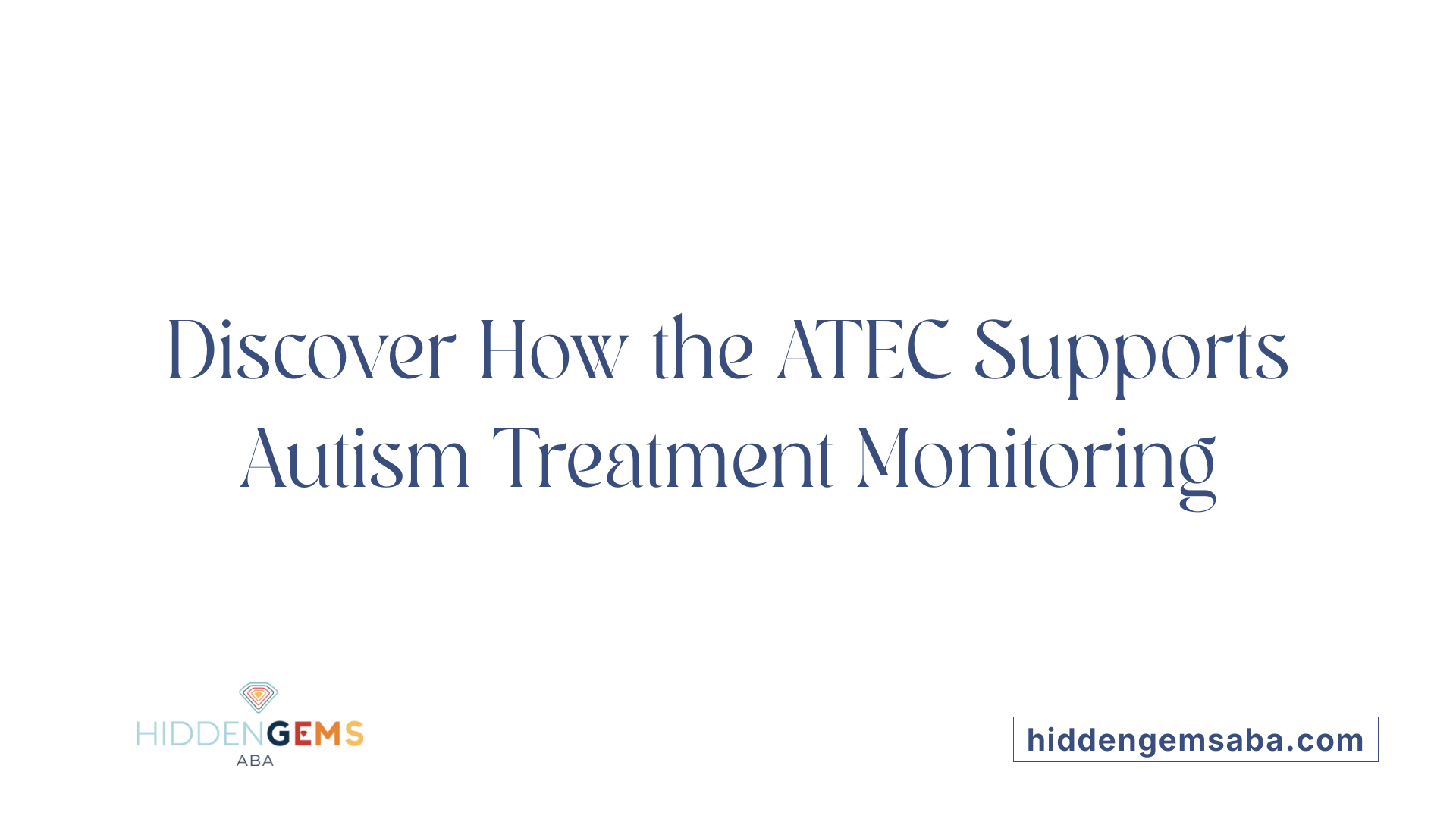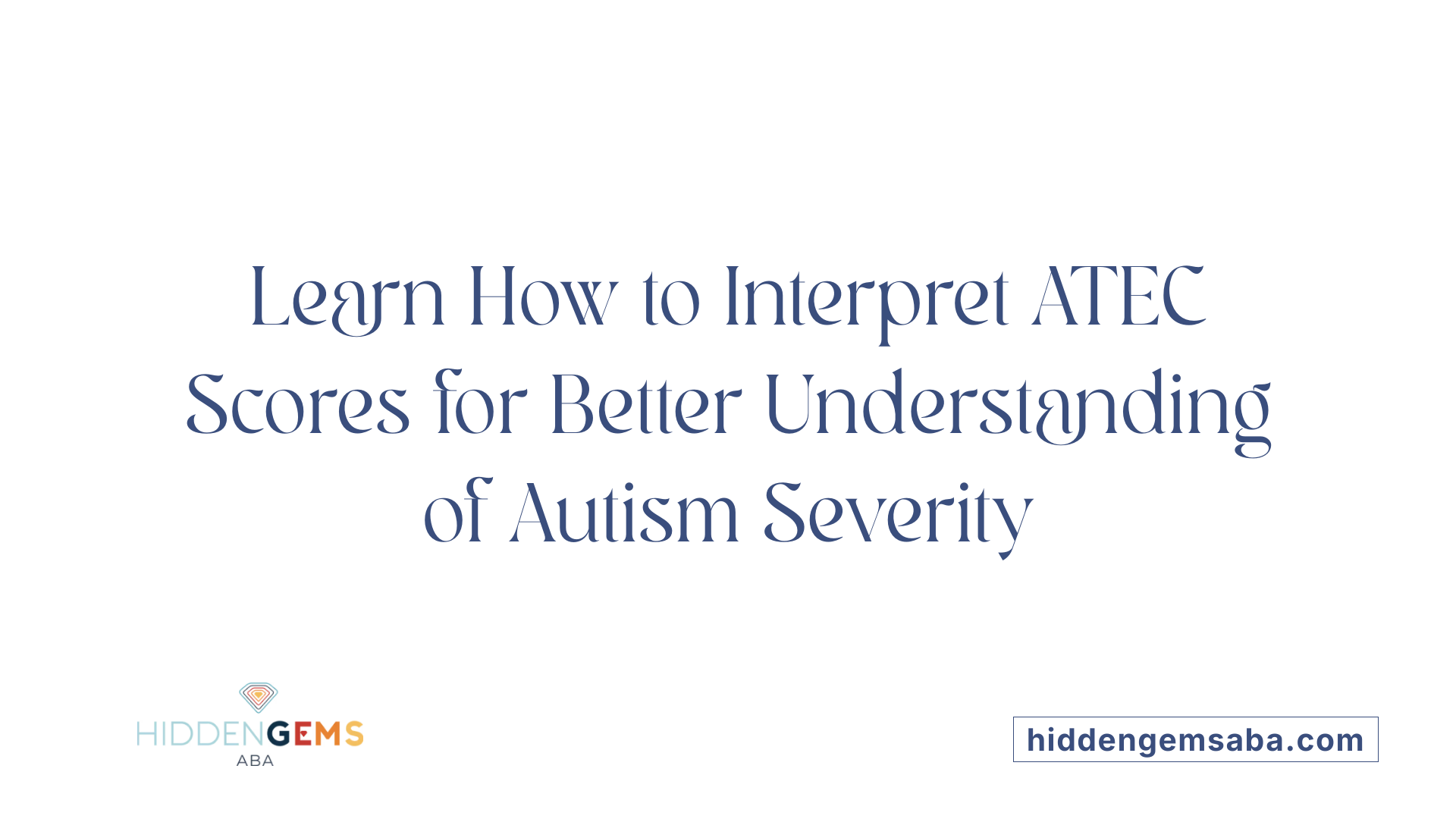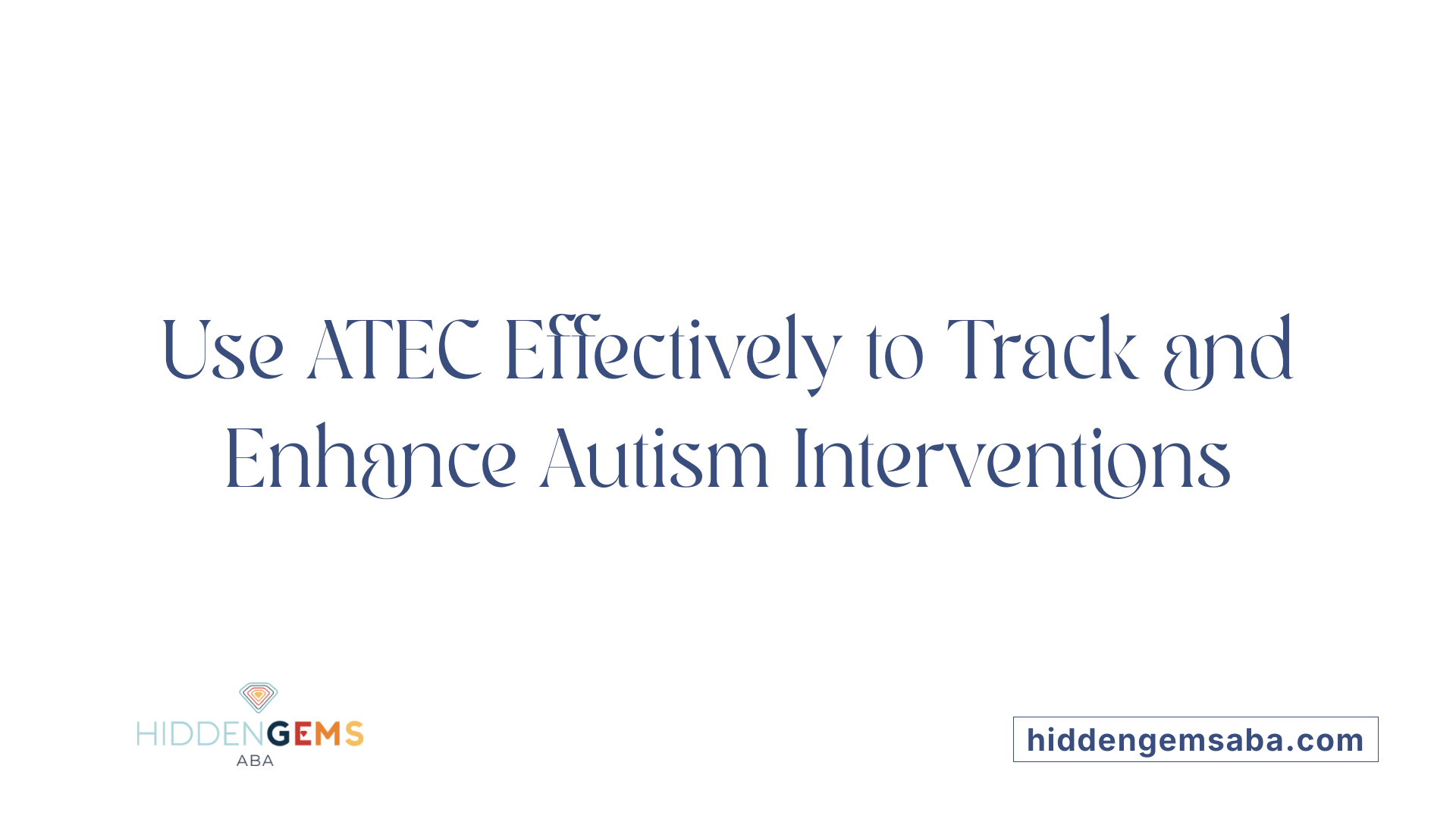Introduction to the ATEC and Its Role in Autism Management
The Autism Treatment Evaluation Checklist (ATEC) is a widely recognized tool designed to help caregivers and clinicians assess the severity of autism symptoms and monitor the effectiveness of interventions over time. Developed in 1999 by Bernard Rimland, Ph.D., and Stephen Edelson, Ph.D., at the Autism Research Institute, it serves as a practical and accessible way to gauge progress in individuals with Autism Spectrum Disorder (ASD) across different developmental stages. This article explores the structure, application, and significance of the ATEC, providing insights into how it supports informed treatment decisions and ongoing autism management.
Structure and Scoring of the ATEC

What is the structure and scoring system of the ATEC?
The Autism Treatment Evaluation Checklist (ATEC) is a comprehensive tool designed to assess the severity of autism symptoms and track changes over time. It consists of 77 items that are organized into four specific subtests: Speech/Language and Communication, Sociability, Sensory and Cognitive Awareness, and Health and Physical Behavior.
Each item in the ATEC is scored based on the caregiver’s observations, typically on a scale that captures the presence and severity of specific behaviors or symptoms. The scores from all items are summed to generate a total score that ranges from 0 to 180 points. In this scoring system, lower scores indicate fewer symptoms and less severity, while higher scores suggest more significant difficulties.
The four subtests are designed to give a detailed view of different aspects of autism. For example, the Speech/Language and Communication subtest evaluates language skills and communication abilities. The Sociability subtest assesses social interactions and social awareness. The Sensory and Cognitive Awareness subtest examines sensory responses and cognitive functioning. Meanwhile, the Health and Physical Behavior subtest looks at physical health and behavioral issues.
This structure allows clinicians, parents, and teachers to monitor progress effectively. Since the total score can change as a child responds to treatments or interventions, it serves as a useful indicator of improvements or emerging challenges over time.
Research supports the reliability of the ATEC, with high internal consistency (Cronbach’s alpha values above 0.94). It also correlates strongly with other standardized measures of autism, reaffirming its validity as a tool for tracking autism symptoms across different domains.
Overall, the ATEC’s design enables a detailed yet easy-to-administer assessment that helps guide treatment planning and monitor developmental progress in children with autism.
Purpose and Applications of the ATEC
 The Autism Treatment Evaluation Checklist (ATEC) is designed to serve as a practical tool for measuring the severity of autism symptoms and evaluating the effectiveness of various treatments. Developed by Bernard Rimland, Ph.D., and Stephen M. Edelson, Ph.D., at the Autism Research Institute, it is widely used by parents and caregivers to monitor progress over time.
The Autism Treatment Evaluation Checklist (ATEC) is designed to serve as a practical tool for measuring the severity of autism symptoms and evaluating the effectiveness of various treatments. Developed by Bernard Rimland, Ph.D., and Stephen M. Edelson, Ph.D., at the Autism Research Institute, it is widely used by parents and caregivers to monitor progress over time.
The ATEC assesses four main domains: speech and language communication, sociability, sensory and cognitive awareness, and overall health and physical behavior. This comprehensive approach allows caregivers to observe and record changes in different aspects of autism, providing an overall picture of how a child is responding to interventions.
The tool is primarily completed by parents, teachers, or other caretakers rather than clinicians. This makes it accessible and convenient, taking approximately 10 to 15 minutes to complete. Since it is caregiver-administered, it offers a real-world perspective on daily functioning and behavioral changes.
While the ATEC is valuable for tracking progress, it is important to note that it is not a diagnostic instrument. The scores, which range from 0 to 180, help identify the severity of autism symptoms and measure shifts over time. Lower scores indicate fewer difficulties, with scores less than 30 at age five suggesting behavior close to typical development. Higher scores, above 104, reflect severe autism that may require continuous care.
In clinical practice, the ATEC helps determine the effectiveness of interventions and guides adjustments to treatment plans. It is recommended to administer the test every 4 to 6 weeks during intervention periods, providing ongoing insights into progress. Overall, the ATEC is a valuable, accessible, and research-supported tool used broadly for treatment evaluation, not for diagnosis or screening.
Interpreting ATEC Scores and What They Mean for Autism Symptoms

How should one interpret ATEC results and what do they indicate about autism?
Interpreting the scores from the Autism Treatment Evaluation Checklist (ATEC) involves looking at both the total score and its individual subscale scores. The total score ranges from 0 to 179, with lower scores indicating fewer autism-related symptoms and higher scores reflecting more severe impairment.
The four subscales—Speech/Language/Communication, Sociability, Sensory/Cognitive Awareness, and Health/Physical/Behavior—offer a detailed view of specific areas affected by autism. By analyzing these, caregivers and clinicians can identify which domains are most impacted and track improvements or challenges over time.
ATES scores tend to change with age, following typical developmental patterns. For instance, scores around 116 at age 2 tend to decrease as children grow older, reaching about 28 by age 12. This decline reflects natural development and the progress made through intervention.
To provide context, the ATEC has established normative data and percentile ranks based on age groups. These allow for meaningful comparisons—e.g., scores less than 30 at age five suggest the child exhibits behaviors closer to typical development, indicating a high likelihood of leading a normal life with minimal ASD symptoms. Conversely, scores of 104 or higher are associated with severe autism, often requiring continuous care.
Interpreting these results within a developmental framework helps determine if a child's skills are developing typically or if there are areas that need targeted support. It also enables tracking treatment effects, seeing whether intervention strategies are helping reduce symptom severity over time. Overall, ATEC scores should be considered as part of a comprehensive assessment, giving valuable insights into the child's unique profile and guiding future care.
Using the ATEC for Monitoring and Evaluating Treatment Progress

How is the ATEC used to assess autism treatment progress?
The Autism Treatment Evaluation Checklist (ATEC) plays a significant role in tracking the effectiveness of autism treatments. Typically, caregivers such as parents, teachers, or other caretakers complete the form every 4 to 6 weeks during ongoing interventions. This regular administration allows for a consistent measure of a child's symptoms and behaviors over time.
The ATEC evaluates four key areas: Speech/Language/Communication, Sociability, Sensory and Cognitive Awareness, and Health/Physical/Behavior. By comparing initial baseline scores with subsequent results, caregivers and clinicians can identify patterns of improvement or areas needing additional support. This ongoing process helps create a clear picture of how a child is responding to different therapies.
Research supports the ATEC’s reliability, making it a trusted tool for measuring changes associated with treatment. Its results can inform decisions, such as modifying existing strategies or implementing new approaches, providing a tailored treatment pathway for each child.
Using the ATEC regularly offers a practical way to document a child's developmental journey. It also enhances communication between families and health professionals, ensuring everyone involved is informed about progress or challenges. Ultimately, this ongoing assessment helps optimize interventions, aiming for the best possible outcomes for children with autism.
Complementarity and Comparison with Other Autism Assessment Tools
How does the ATEC compare with other autism assessment tools?
The Autism Treatment Evaluation Checklist (ATEC) stands out because it is designed primarily for ongoing monitoring rather than initial diagnosis. Developed by experts Bernard Rimland and Stephen Edelson, the ATEC is a caregiver-administered questionnaire that parents, teachers, or caretakers can complete easily at home.
Unlike clinician-led assessments such as the Autism Diagnostic Observation Schedule (ADOS) or the Childhood Autism Rating Scale (CARS), which are detailed, standardized procedures used mainly for diagnosing autism, the ATEC focuses on tracking changes over time. It looks at four main areas: speech and communication, sociability, sensory and cognitive awareness, and health and physical behavior.
This emphasis on functional improvements makes ATEC especially valuable during intervention, allowing caregivers to observe and document progress regularly. Typically, the ATEC is administered every 4–6 weeks to gauge treatment effects and adjust strategies accordingly.
While tools like ADOS and CARS provide a comprehensive snapshot of autism severity at a given point, they require trained professionals and are less practical for frequent administration. In contrast, ATEC's ease of use and quick completion time of 10–15 minutes make it highly accessible for regular use.
In summary, ATEC complements traditional diagnostic assessments by offering a practical way to monitor and evaluate ongoing treatment outcomes, making it a vital resource for families and clinicians aiming to observe real-world changes in autism symptoms.
| Tool Type | Administered By | Main Purpose | Advantages | Limitations |
|---|---|---|---|---|
| ATEC | Caregivers | Track treatment progress | Easy, quick, home-based, monitors over time | Less detailed for initial diagnosis |
| ADOS | Clinicians | Diagnostic assessment | Standardized, comprehensive | Time-consuming, less frequent use |
| CARS | Clinicians | Severity rating | Widely used, reliable | Less suited for ongoing progress tracking |
This comparison highlights how ATEC serves as a practical companion to more detailed, clinician-led assessments, especially valuable for tracking developmental changes in a real-world setting.
Conclusion and Practical Recommendations for Using the ATEC
The ATEC offers a practical, reliable, and validated means for caregivers and clinicians to monitor autism symptoms and track treatment progress over time. Its simplicity and focus on functional changes make it an invaluable part of ongoing autism management. Regular administration allows for timely intervention adjustments, and its alignment with research-backed norms enhances interpretive confidence. To maximize its benefits, caregivers should use the ATEC consistently every 4-6 weeks, document changes, and collaborate with healthcare professionals for comprehensive treatment planning. As a complementary tool alongside other assessments, the ATEC can significantly contribute to tailored, responsive approaches for children with ASD, ultimately supporting improved developmental outcomes.
References
- Autism Treatment Evaluation Checklist (ATEC)
- Autism Treatment Evaluation Checklist
- Autism Treatment Evaluation Checklist (ATEC)
- Autism Treatment Evaluation Checklist (ATEC)
- Autism Treatment Evaluation Checklist (ATEC)
- Autism Treatment Evaluation Checklist (ATEC)
- Is the Autism Treatment Evaluation Checklist a useful tool ...
- Longitudinal Epidemiological Study of Autism Subgroups ...
- History of Treatment Evaluation Checklist






